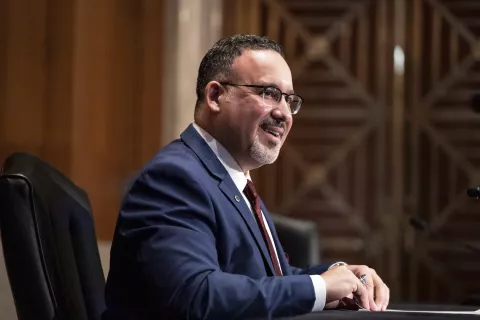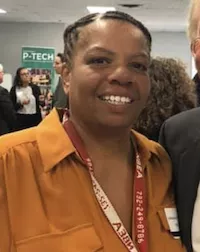Key Takeaways
- Schools and districts with collaborative structures in place responded nimbly throughout the pandemic.
- Some have begun to tackle racial inequities in education through collaborative practices.
- NEA and the New Jersey Education Association announced a new partnership to help other schools and districts around the country foster labor-management collaboration.
Jim Dolan, president of the Montgomery Township Education Association (MTEA) knows that some refer to his central New Jersey school district as a “land of unicorns and rainbows.” That’s because the district and the union are committed to collaborative practice, through which they make decisions together.
But like all districts across the nation, the onset of the pandemic brought confusion and anxiety for educators, administrators, and families alike.
Since 2014, MTEA and school district administration have worked with the Rutgers School of Management and Labor Relations to supplement their traditional labor-management relations with collaborative structures and practices that bring union, district, and community stakeholders together. Having those structures in place—and the trusting relationships to support them—made for a more informed crisis response, Dolan explained.
“We needed to prepare staff for the uncertainty of September,” Dolan said, in just one example. With educators involved every step of the way, “we came up with creative solutions for professional development during the month of August…[that] allowed us to honor the contract, prepare staff, and have full buy-in because of our flexible design.”
Montgomery Township was one of seven Garden State districts that spoke about how labor-management collaboration helped them navigate the Covid-19 pandemic and begin to tackle institutional racism at the virtual New Jersey Public School Labor-Management Collaborative Inter-district Conference on Wednesday.
“Collaboration does not mean we always agree—and Covid certainly presents plenty of opportunities to disagree,” Dolan said. “Collaboration means…we have chosen to sit at the same table to plan together, rather than file grievances after decisions are made.”
“I can’t remember the last time we actually filed a grievance in Montgomery,” he said. “It’s a testament to our structure and commitment to working together at all levels.”
Building on Success
While traditional labor-management models revolve around top-down change—the school district enacts new policies, and the educator union responds—collaborative practices are rooted in open communication and shared decision-making.
That means educators are at the table alongside administrators and other stakeholders such as school board members, parents, and students. Educator voices are heard before decisions are made.
“I feel respected when I go into meetings. I feel heard,” said Melissa Vega, 1st vice president of the New Brunswick Education Association. “It’s a huge difference from 16 years ago when I first came into the district. It’s definitely better and continues to improve.”
The model has the attention and support of state leaders, including Gov. Phil Murphy, who addressed conference attendees in a recorded message. He praised New Jersey educators for engaging in labor-management collaboration, and for “reinventing public education nearly overnight” at the onset of the pandemic.
U.S. Education Secretary Miguel Cardona offered a message of support, thanking educators for keeping students at the heart of their efforts and establishing partnerships with all stakeholders.

“When labor and management work together with common purpose, we discover strategies that are not only innovative, but obtainable and sustainable,” Cardona said. “We create trust, capacity, and ultimately, real solutions for students and communities.”
Cardona said the Biden administration is creating a best practices clearinghouse to collect examples of successful, solutions-based approaches like those highlighted during the conference to share with other districts across the country.
New Jersey is a pioneer of labor-management collaborative practice.
The New Jersey Public School Labor-Management Collaborative began nearly eight years ago with the support of Saul Rubinstein, a professor in the Rutgers School of Management and Labor Relations.
“We see a very clear relationship between what happens between the adults in the building—the collaboration among educators at all levels—and a positive impact on student learning,” Rubinstein said.
Through studies conducted in 2011, 2012 and 2014, Rubinstein and co-author John McCarthy of Cornell University have found that formal labor-management partnerships help improve student performance, lead to more extensive communication between educators, more frequent informal communication between union representatives and school principals, and enhance learning among schools leading to the adoption of innovation from one school to another.
To date the Collaborative includes 23 districts with 128 schools, 450 administrators and 7,680 teachers who teach 77,172 students.
Now, NEA wants to help New Jersey build on its success, and inspire districts in other states to start engaging in labor-management collaboration.
NEA President Becky Pringle announced at the conference that NEA is providing the New Jersey Education Association (NJEA) with a $500,000 grant to help expand the New Jersey Public School Labor-Management Collaborative and additional funds to help other interested state and local affiliates to plan and launch partnerships that foster labor-management collaboration practices in districts and worksites. NEA has committed to invest more than $3 million over three years to fund and grow this initiative.
“NEA is committed to leading a movement to unite our members and this nation to transform public education into a racially and socially just and equitable system...” said NEA President Becky Pringle. “Building a nationwide system that fosters and supports labor-management collaboration is essential to that vision.”
“The bottom line is—and always has been and always will be—the effect this work has on our students,” said NJEA President Marie Blistan. “New Jersey’s schools are ranked number one in the nation, and one of the reasons our public schools perform so well is because local associations and school district administrators in our state work together in areas where we share common ground. In partnership with NEA, we will be able to take to a national level the lessons we have learned here in New Jersey.”
Confronting Institutional Racism Together
Another advantage of labor-management collaboration is that it allows parties to address student-centered issues that fall outside the scope of collective bargaining.
Even as they navigate the ever-changing demands of the pandemic, these New Jersey unions and school districts are using collaborative practice to confront the opportunity gap between white students and students of color.
To address long-standing racial inequities, the New Brunswick School District established an Equity Alliance that includes two or three educators from each school. After reviewing discipline data, the Alliance acted to change district discipline policies and remove oppressive language.
The result is that far more students stay in the classroom and are coached in self-management rather than pushed out of school.

“We also have Courageous Conversations, established by principals and association members,” said New Brunswick Education Association President LaShaun Arrington. “We can have difficult conversations in a safe space. When you see administrators, union leaders, parents, and board of education members all in a room together that’s very powerful and says we are there to understand each other.”
By nature, good collaborative structures support open and honest conversation.
“I felt comfortable going to my principal to share what I was seeing regarding equity as a person of color,” said Joanna Tiu, a special education teacher at Montgomery Upper Middle School. “That’s due to the collaborative practices. I never would feel comfortable doing that at my old district.”
“We’ve been working on institutional bias and racism for about one-and-a-half years,” said Brett McLaughlin, a 4th-grade teacher from Delran Township School District. The work has included exploring the underrepresentation of students of color in gifted programs, instituting culturally responsive practices, and looking at history through different lenses.
“Now we’re working through how to convince more people across the district that we need to make some changes.”
FIND OUT MORE:
NEA resources on collaborative practice will introduce you to the framework for collaboration, backed by research that shows how labor-management collaboration benefits students and entire school communities.


